

Most ebook files are in PDF format, so you can easily read them using various software such as Foxit Reader or directly on the Google Chrome browser.
Some ebook files are released by publishers in other formats such as .awz, .mobi, .epub, .fb2, etc. You may need to install specific software to read these formats on mobile/PC, such as Calibre.
Please read the tutorial at this link: https://ebookbell.com/faq
We offer FREE conversion to the popular formats you request; however, this may take some time. Therefore, right after payment, please email us, and we will try to provide the service as quickly as possible.
For some exceptional file formats or broken links (if any), please refrain from opening any disputes. Instead, email us first, and we will try to assist within a maximum of 6 hours.
EbookBell Team

4.1
70 reviewsRemote Instrumentation and Virtual Laboratories focuses on all aspects related to the effective exploitation of remote instrumentation; on making instrumentation fully integrated into the e-Science scenario by considering middleware, networking, and metrological aspects; and the building of complex virtual laboratories on top of real devices and infrastructures. These include SOA and related middleware, high-speed networking in support of Grid applications, wireless Grids for acquisition devices and sensor networks, Quality of Service (QoS) provisioning for real-time control, measurement instrumentation and methodology, as well as metrology issues in distributed systems.
The activities generally termed "e-Science" encompass a wide range of scientific disciplines. It is characterized by highly intensive computation on huge data sets in a large-scale distributed environment, by the real-time interaction and collaboration among many scientists working on a specific problem or data set worldwide, and by the use of specific instrumentation—the pieces of equipment physically producing the data that pertain to a certain experiment.
In addition to remote instrumentation, this book also addresses new challenges that will arise from wireless access, wireless sensor networks, and the traversal of heterogeneous network domains.